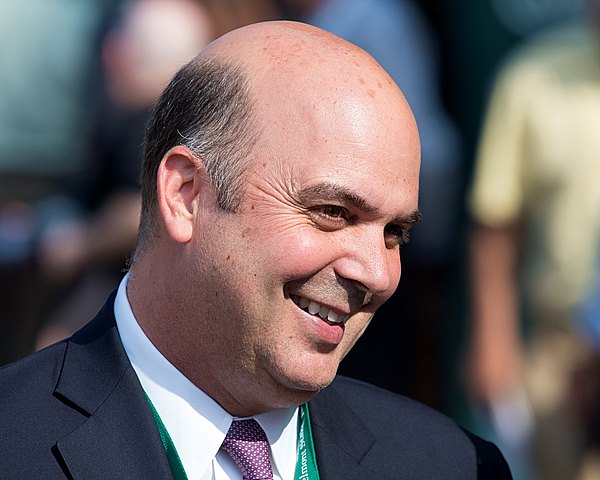It's rapidly approaching a year since the last time the general public has been allowed on the grounds of a New York Racing Association racetrack.
Yet, if you peruse the condition book for the ongoing winter meet at Aqueduct Racetrack, you'll see some numbers attached to dollar signs that may be surprising.
"This winter we had a better purse structure than any time in the summer or fall," said owner Kip O'Neill, who races under the banner of Windylea Farm, "and that's extremely helpful in operating our stable."
About two months from now, those numbers will take on even more glitter. When the upcoming spring/summer meet begins at Belmont Park, it will offer record purse levels across the board that will help both NYRA's biggest and smallest outfits and is being viewed as a means to boost field size and spur more wagering.
At the top end of the scale there will be $90,000 maiden special weight races and allowance races that begin at $92,000 and rise to $96,000. In comparison, at the 2020 fall Belmont meet, maiden special weight races were worth $63,000 with a first level allowance race carrying a $65,000 purse. At the current Aqueduct meet the purses are an extremely healthy $80,000 and $82,000 for those levels, yet that's $10,000 below what awaits horsemen at Belmont Park when that meet begins April 22.
"The purse increases are very welcomed. It's creating a good situation for the horsemen and the owners to continue the process of digging out from the storm of last year and the pandemic. NYRA should be applauded for what they are doing," said Chad Brown, NYRA's leading trainer the last six years.
Yet the most important facet of the higher purses could be the greatly enhanced rewards in claiming races that have the potential to lure horsemen from all across the country to New York to compete for highly lucrative pots they will be hard-pressed to find anywhere else. At each open level through $25,000, the purse will be more than double the claiming tag.
"I'm hoping owners from across the country see these purses and say 'Let's go there and try it.' Most of our levels are going to be 25% to 50% higher than anyone else," said Martin Panza, NYRA's senior vice president of racing operations. "I've never seen a better time for people to form claiming syndicates or for trainers to sit down and think about claiming horses."

As an example of the financial incentives at the Belmont Park meet, a $16,000 claiming race will be worth $42,000, which amounts to a $23,100 payday for a victory and $8,400 for second. A $25,000 claimer has a $55,000 purse, and—at opposite ends of the scale—a $10,000 claimer will offer $28,000 in purse money and a $62,500 claimer a robust $80,000.
"This creates opportunities where you do not have to compete with (trainers) Todd Pletcher, or Chad Brown, or Christophe Clement, or Shug McGaughey, and if they drop a horse into a claimer you have the ability to claim it. So that playing field is very even," Panza said. "It's very hard to go to yearling or 2-year-old sales and then wait six months or a year-and-a-half before the horse runs. It's hard to get lucky doing that, whereas with these claiming purses so high there's an opportunity to make a good living. When you crunch the numbers, you have opportunities to make some money in a short period of time and have some fun doing it."
Since NYRA's Feb. 18 announcement of the enhanced purse structure for the 48-day Belmont Park meet, anticipation for the richer purses has been growing among horsemen, especially those with a heavy concentration of claimers.
"It can spark some added interest in claiming horses," said trainer Rob Atras, who is fourth at the Aqueduct winter meet with 12 wins. "The purses are already good and the increases make it better. People are already doing quite a bit of claiming here but it will keep people claiming and bring new people here."
Atras said he has already spoken with several owners who have expressed interest in sending horses to New York once Oaklawn Park's meet ends May 1.
"The purses are definitely enticing, so It's certainly going to attract some people to bring horses here from other tracks for the spring meet and take a shot at those purses," he said. "I've had a few people take interest in shipping here after Oaklawn. We'll have to see what happens with that."
O'Neill, who has 15 horses stabled in New York with Atras, Mark Hennig, and Rick Schosberg, said he's scanning the entries at several racetracks in hopes of finding runners for springtime on Long Island.
"We are looking at New York as the focus market for us and it always will be," said O'Neill, whose Windylea operation is tied for second in the owners standings at Aqueduct with seven wins. "We have some horses in Texas and (Fair Grounds Racecourse & Slots) and Florida, but New York is where we are based. We appreciate the purse structure and the breeding program there, it's very attractive. We are looking for horses in other jurisdiction to bring to New York and hope to bring a few up there."

One intriguing addition is a $250,000 claimer which will be offered for older males April 23 and older females May 6. Both races will be contested at 1 1/8 miles on turf with a $100,000 purse.
"There are older horses selling at horses of racing age sales, so we were thinking if you have a 6-year-old gelding who is out of conditions, would you be willing to take $250,000 for it plus a big share of a $100,000 purse?" Panza said. "We figured we'd put it out there and see what kind of response we get. You have these valuable horses and there may not be an overnight race for him, but in the claimer If you run second you can walk away with $270,000 and that might be attractive. There are more turf horses in this category, so we thought we'd try it there first and then add a dirt race if there's a good response."
A key part of getting the word out about the ritzy levels came with the release of the first Belmont Park condition book at the same time as news of the purse increase, allowing horsemen to target spots at the meet well in advance.
"It's always helpful to have that condition book in hand early. It helps everyone prepare," O'Neill said. "You can have horses in high level claimers or allowance races now at Aqueduct that will not run at those levels at Belmont, so knowing what's out there this far in advance, you can chart a path for them. We live by the condition book. It's what drives the bus, so getting it early is huge for us."
Adding even more honey to the pot in hopes of bringing new faces to the Belmont Park backstretch, NYRA introduced an "Oaklawn Ship & Win" program that will offer a 30% purse bonus for the first two NYRA races at the Aqueduct spring meet or Belmont Park spring/summer meet by horses who made their last start at the 2021 Oaklawn Park meet. Those connections will also receive a $1,500 check to cover any expenses.
"With the 30% Oaklawn bonus, you are running for $71,500 in a $25,000 claiming race," Panza said. "I don't know how you lose money doing that."
Aside from the Oaklawn offer, there's also a shipping program linked to the Fair Hill Training Center.
Panza is also quick to point out several other benefits of racing in New York, such as a trainer's first 12 stalls being free of workman's compensation costs for jockeys and exercise riders with a daily charge of $1.60 a day for additional stalls.
There's also no tax on claims, just a 1.5% Aftercare assessment, plus the potential for voiding claims if a horse exits a race with a physical issue.
NYRA also conducts its Under 20's Claiming Challenge which awards a total of $80,000 twice a year to trainers with 20 or less horses, with a top prize of $16,000 each time.
Combined, it has created a win-win situation for everyone who races at NYRA tracks.
"Everything is going up in terms of costs so thank God the purses are also going up," said Gary Sciacca, who has been training at NYRA tracks on a year-round basis for 40 years and has 30 horses under his care. "The better purses are saying 'You guys need a shot.' They seem to understand what's going on and NYRA is really doing the right thing."
Beyond what's available now, Panza is hopeful that legislation giving trainers health coverage will be included in the next New York State budget and will go into effect Jan. 1, 2022. The proposal would cover trainers who make at least 43 starts in New York with 60% or more of their overall starts taking place at a NYRA track.
"This would provide health care on at least a silver level," Panza said.
The genesis of the record purse levels came in the fall during meetings of NYRA's Racing Committee. The group, chaired by Stuart Subotnick, took into consideration the hefty purses offered at Oaklawn Park and Kentucky tracks, and voted for an across the board bump to help everyone already racing at NYRA and bring in new outfits to bolster field size.
"We really tried to focus the purse increases on races with purses of $40,000-$100,000, which is our core. They are the bread and butter of our overnight program and we hope it will attract the most people here," said New York Thoroughbred Horsemen's Association president Joe Appelbaum, who is a Racing Committee member along with Stuart Janney III, Steven Duncker, Andrew Rosen, Ogden Phipps II, and Najja Thompson. "We have the highest-funded claiming program in the country and it's not just cheap claimers. The $40,000 or $50,000 claimers are good horses. I think (NYRA president and CEO Dave O'Rourke)'s leadership financially has been superlative and that allowed us to get to where we are today. So far there's been good feedback from horsemen. Everyone likes a purse increase."
While a trainer such as four-time Eclipse Award winner Brown may not benefit as much as most trainers from the new claiming purses, he understands the value of lucrative purses for all in keeping the wheel turning on a year-round basis.
This winter, Brown's horses have earned $728,827 at Aqueduct in 29 starts, while his Florida string has $380,460 in earnings through 65 starts at the Gulfstream Park Championship Meet.
"It's important to maintain an ecosystem at all levels of ownership and keep everyone in the game. I've always been an advocate of trying to institute purse increases evenly and take care of all stake holders," Brown said. "Our first objective is to support New York, our main base of operation, and our horses have been rewarded with really good purses. It's a stark contrast with other circuits."
A key to funding the increases was a reduction in racing days and cuts in stakes purses. Among the changes were the elimination of Wednesday racing outside of Saratoga Race Course, plus extended dark days after the Spa meet and at Christmas.
"The reduction in race days is a function of not just helping us find purse money but everyone is struggling to find horses," Panza said. "You couldn't run five days a week at Belmont when field size was struggling. We want to put out a good product so less race dates was an opportunity that arose."
While he's hopeful that higher purse will benefit field size, Panza is confident more money coupled with NYRA's vigilance and stellar safety record of protecting horses can resurrect an old niche for a new breed of horsemen.
"When I got into the game you had five-to-seven owners and claiming was all they did," Panza said. "You had trainers and that's all they did. They ran a claiming barn with one or two big owners and they made a nice living doing it. They knew everything about every horse on the circuit. I'm not sure if it's a lost art, but we're hoping to bring that back and create some great opportunities for horsemen."








